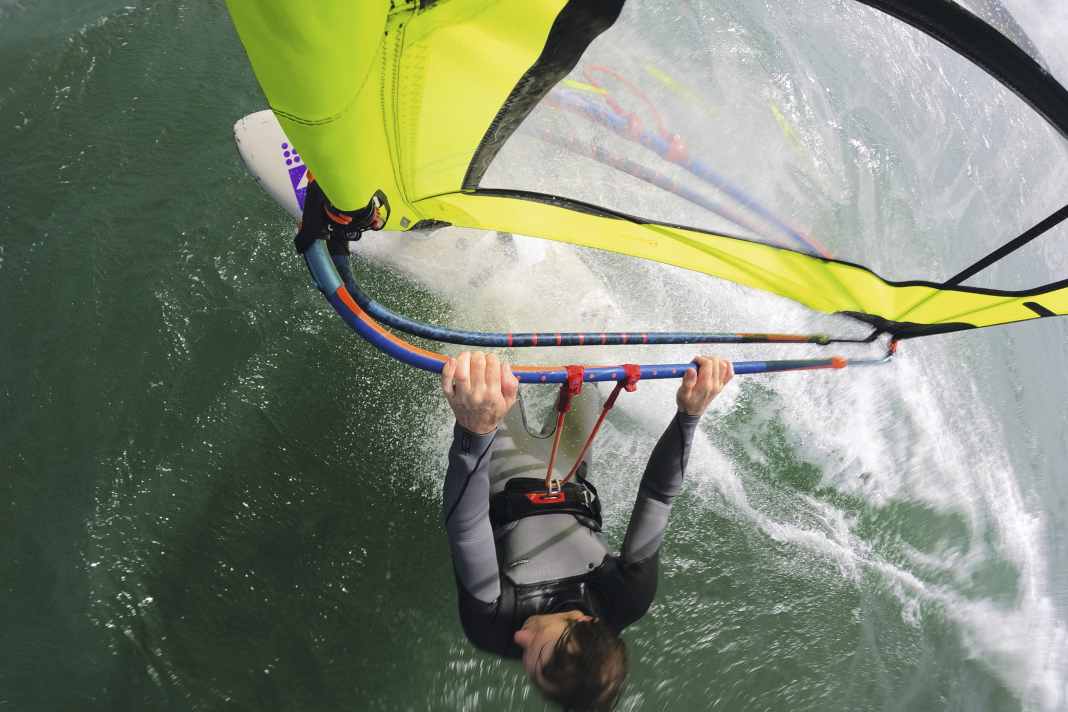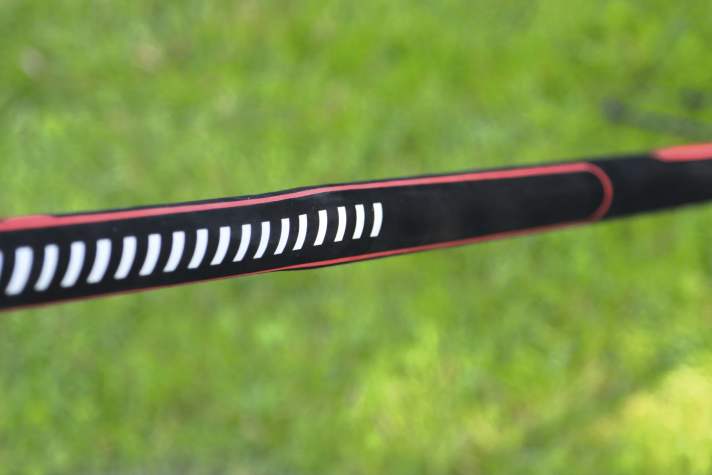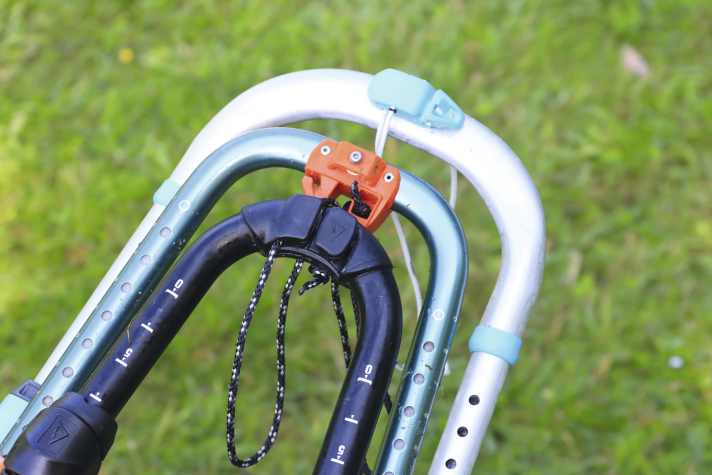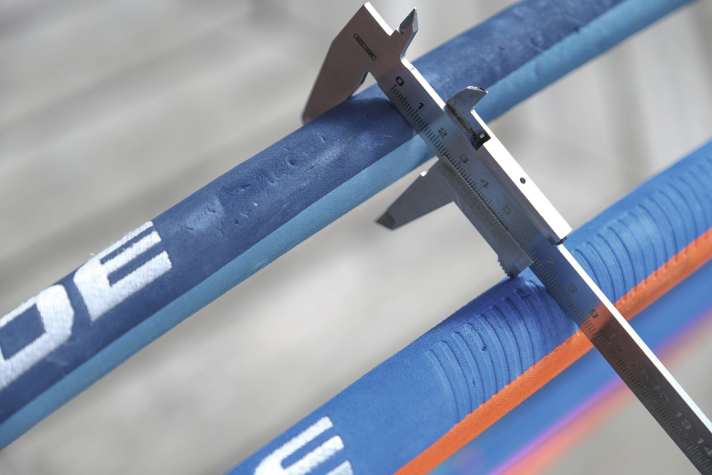





Don't worry, we didn't seriously test booms like in the picture above. Part of our test and editorial team took the long freeride booms for a spin on Lake Garda, while the crew in the north swarmed out to Denmark with a load of wave forks in their luggage. The mission was the same: to compare different boom systems. Choosing the right boom is not always easy: what length makes sense? Is it really more relaxed to surf with oval handles than with round bars? What are the benefits of a carbon fork - apart from a hole in the household budget? And what do I need to consider when choosing the width of the back end? Here are the answers!
The goal: Light, thin and stiff at the same time
It's obvious that you have a more relaxed grip on thin bars. But why are there different tube diameters? In general, manufacturers always try to balance three parameters against each other: high stiffness, low weight and small grip diameter. These aspects are directly related. Stiffness can be achieved by increasing the diameter of the handlebar, for example, but this reduces comfort when gripping. Alternatively, you could also increase the wall thickness of the bar, which would also make the boom stiffer and thinner, but would also make it heavier - as a designer, you end up going round in circles. This is where carbon comes into play - stiff, thin and light, this combination works best with carbon forks. If it weren't for the price, because a good carbon fork costs between 600 and 1000 euros, even in the 140-190 centimetre length. For the same money, you can get three to four standard aluminium forks, depending on the brand and model.
The shape of the spars
Because not everyone can and wants to afford a carbon fork, manufacturers offer various aluminium models. Some of these differ in the shape of the spars. Brands such as Aeron or GunSails have so-called V-grip forks in their range, where the spars are slightly tapered on the inside. This is intended to provide better stiffness when pumping, when the boom is pulled apart, so to speak, and to correspond more to the natural shape of the hand.
Of course, there are also big differences in the spar diameters. It is important to know that the manufacturers usually specify the thickness of the bare spar, with the coating adding another 2 to 2.5 millimetres. A Severne Enigma carbon fork with a diameter of 24.5 millimetres according to the manufacturer then becomes a 27 mm diameter in practice. You should also bear in mind that the thickness specification for some boom models refers to the grip area, but the booms become noticeably thicker further back - where you often grip during manoeuvres or when riding waves. But how big are the differences in practice on the water? What we noticed during testing is that it makes a difference whether you are "just" surfing back and forth with a boom or whether you are freestyling with the boom or going into the wave.
Wave, freestyle & manoeuvres
We have tried out the following booms in the shaft as examples:
- GunSails Cross 140-190: This is an inexpensive aluminium fork (189 euros), which has an average 29 mm diameter at the front in the grip area, then swells to 32 millimetres at the rear, which should provide additional stiffness. With a weight of 2.68 kilos, it is within the normal range.
- NeilPryde X-FS 140: Exemplary for many standard aluminium forks - a 30 mm spar diameter runs from front to back, without any big gimmicks. The weight: 2.72 kilos.
- GunSails V-Cross 140: This is representative of the models with V-Grip; due to the double-walled construction at the front, this type of boom is somewhat heavier, our test boom weighed 2.91 kilos. The handle diameter measured horizontally is a full 34 millimetres, but this is not decisive. The question of how quickly you get fat forearms is determined more by the vertical diameter - and at 29 millimetres, the V-Grip's diameter is quite appealingly thin.
- Duotone Silver Mega Slim 140-200: Probably the thinnest aluminium fork on the market! The diameter here is only 26 millimetres when measured vertically, which is less than many carbon forks. Horizontally, the spar diameter is slightly larger at 28 millimetres, which should keep the stiffness within limits. The weight of the Duotone model is also very appealing at just 2.47 kilos.
- Severne Enigma 140: Representative of the thinnest carbon forks. A measured diameter of 27 millimetres is the maximum you can currently get on the market. With a weight of 1.93 kilos, the boom is just under a kilo lighter than the heaviest model in the test.

Test impressions of the "small" booms
20 to 30 knots of wind, head-high ramps and a stack of booms right at the water's edge - that was our test set-up at the Danish top spot Hanstholm. Because the changeover only takes two minutes, the differences are immediately noticeable.
GunSails V-Cross 140
The oval shape of the V-Grip, which tapers to a point in the finger area, is easy to get used to after a short familiarisation period. On long strokes, the boom fits the shape of the hand very well, which ensures a relaxed grip. What also becomes clear, however, is that when riding waves, manoeuvres or freestyle tricks, you grip differently than when freeriding straight ahead - and then the unconventional shape fits noticeably less. What's more, the V-Grip booms are noticeably heavier on average due to their double-walled construction: "On the straight," says surf tester Julian Wiemar, "the shape moulds itself well at some point, I can then already have a relaxed grip. But as soon as I move on the wave or in manoeuvres on the boom, the shape tends to bother me when gripping. Then I prefer a boom with evenly rounded bars." Of course, as expected, the V-Grip is very stiff, but in manoeuvres and when riding waves - i.e. whenever the sail leaves a rather static riding position and rotates - the boom makes the sail noticeably more sluggish due to its higher dead weight.
NeilPryde X-FS 140
Switching to the standard aluminium boom with the same spar diameter felt better in this context. The fact that the spars are perhaps a tad less stiff simply doesn't matter, but the round spars don't feel like a foreign body when doing tricks and the lower weight makes the sail noticeably more agile and more pleasant to rotate - regardless of whether you are jibing or rotating a loop or freestyle move.
GunSails Cross 140-190
The effect of a few millimetres on the boom diameter can be seen in the GunSails Cross boom, which is around three millimetres thinner at the front than at the rear. If you surf safely and relaxed in the harness and cruise long strokes, you should not be bothered by the comparatively thick 32 mm diameter in the rear area - simply because you don't normally grip with full force and the rear hand is only loosely on the boom. The picture is completely different on long surf days in the waves. When jumping and riding down the wave, you surf with a wide grip on the boom. The back arm then tires noticeably faster. If, after two hours on the water, you've done a long ride with several turns on the wave, you'll notice that your front grip is quite relaxed and your back forearm is already getting sore.
Severne Enigma 140
From this point of view, the switch to the carbon fork is a blessing. Two millimetres less diameter sounds like splitting hairs, but in practice it's a world away. Incidentally, it doesn't matter whether you have small hands or paws, you simply surf more relaxed and de facto longer. From experience, we can say that this perceived advantage is even greater if you are travelling with gloves in the cold season. And the perceived weight? If you switch from the heavy V-Grip boom to carbon, the difference is very noticeable. But: It's just a feeling, because the sail rotates more nimbly and is a little more agile in the hand. Nevertheless, you won't surf any faster with it, nor will wave moves or jumps be any better just because you're riding a carbon fork.
Duotone Silver Mega Slim 140-200
The change to the thin aluminium fork was also exciting for us. It feels almost as light in the hand as the carbon fork - however, this is less due to the weight and more to the wonderfully thin spar diameter. Mounted on a 5.0 sail and half extended, there is hardly any disadvantage in terms of stiffness, even with hard backloop landings. After a few hours on the water, our testers were unanimous: the thin aluminium boom is just as relaxed to surf with as the carbon model.
Important: Narrow or wide back end?
The test is over, the wind and waves are getting better and better. Our lighter tester Julian (78 kilos) immediately grabs the carbon fork for the after-work surf. He doesn't have to argue with his heavier colleague Manuel (92 kilos), because our comparison brought another important detail to light: the question of the right back end. Background: heavier people ride the same sail size in significantly more wind and sometimes with a more bulbous trim. On booms with a narrow back end - including the GunSails Cross and the Severne carbon boom - the sail quickly reaches the harness lines. "I would then have to trim the sail flatter than would be good, and the boom would rub against the sail the whole time during landings and strong gusts. That's why I would never use a boom with a narrow back end," explains surf editor Manuel Vogel. So is the carbon fork superfluous in the waves? Probably not, because even the thinnest aluminium fork can't make up for one disadvantage: Carbon does not bend! And anyone who jumps a lot and wants to push the adjustment range of their wave or freestyle fork to the limit is always on the safer side with carbon.

Thin boom, thick plus - also for freeriders
Freeride test 2024 - the surf testers have access to three different fork models for the test of the 7.0 no-cam sails: the particularly thin Duotone Silver Mega Slim aluminium forks in lengths 180-240 and 160-200 as well as the GA Hybrid 170-230 with a stiff carbon back end. The testers are unsuspecting guinea pigs. Parallel to the sail test, they observe which booms they favour and which ones are left behind. Surprisingly, the presumed high-end boom with a carbon back end is almost as good as new in the end - maximum stiffness loses out to grip comfort in the practical test. The most popular choice for most freeride sails is the very short 160 "Slim", which has tubes two millimetres thinner in diameter than the 180 boom and is therefore in the range of thin carbon wave forks. However, both are priced between conventional aluminium forks and high-priced carbon models. Although the 160-220 no longer has maximum stiffness at 40 centimetres extension, it is simply lighter and easier to handle on long hits and manoeuvres. The influence of the boom on the perceived handling of the entire rig is so great that in surf tests every tester has always kept "his" boom when changing sails or usually all sails are rigged with the same boom.
Diameter almost more important than stiffness
Second act: Fork test on Lake Garda. Even though the aluminium fork (NeilPryde XF) has slightly more play "up and down" when pumping hard, it is "absolutely stiff enough on the 7.0 sail when half extended, but you can feel the difference to the carbon fork immediately", was the unanimous verdict of the testers. This refers to the perceived rig feeling, "the sail seems lighter and more playful with the NeilPryde X-CS Freerace carbon fork". The decision? "Clearly in favour of the carbon fork - not because of the stiffness, but because it has a better grip and the rig feels safer, lighter and can be held with less force". 29 versus 32.5 millimetres in diameter (including grip) doesn't sound like that much at first. In terms of circumference (U = * E), however, there is a good centimetre between these two tubes, which explains the clearly noticeable effect. Incidentally, NeilPryde also offers aluminium forks with two (XA) and three (XF-S) millimetre thinner bars in addition to the "XF".

Modern aluminium against old iron
At 2.7 kilos, our vintage treasure, the North Pro.Gression, is the second lightest boom in this comparison and, with a diameter of more than 33 millimetres, offers good stiffness. Nevertheless, the boom simply feels bulky and outdated. This feeling is underpinned by the very narrow back end, which is not well suited to the loose clew trim of powerful freeride or freerace sails. In contrast, the current 180 mm "Slim" boom with a 30 mm diameter looks downright filigree.
Not all carbon is the same
Apart from extremely powerful racing or on really large sails, you can hardly accuse cheaper aluminium forks of having a performance disadvantage. However, this is where the big carbon fibre bangers come into play, which make quite an impression visually with a roll-trimmed back end like the cockpit of an F50 racer from the Sail GP and fat AMG-style tailpipes. Our reference model GunSails Select Carbon in 180-240 weighs 3.35 kilos, measures 32 millimetres in the grip area with coating and 39 millimetres at the back end. You could almost think you're gripping the mast when you're shoving in the Duck Jibe. "But lengths like that are hardly sold any more," says surf tester and surf shop salesman Frank Lewisch. And the next smallest length 160-220 is noticeably thinner, even with the comparatively very affordable GunSails carbon fork, and the 140 wave fork is even thinner.
In comparison, the NeilPryde XC-S Freerace 175-225 carbon fork is already tuned for freeride and freerace use, dispenses with the thick end and impresses with its slim 20-30 millimetres (slightly oval) in the grip area and only 2.65 kilos with the best handling in this test group. The same sail almost feels like a size smaller. With the NeilPryde XC-S Race, which is also available, you are not doing yourself any favours in many cases, because the handle area and the spars are significantly thicker with the same basic length, there is no gain in comfort compared to an aluminium fork, and the massive back end with integrated trim system is practical for racing, but noticeably oversized for freeride or freerace.
The boom - the underestimated tuning object
The boom is underestimated as a tuning object. Even for freeride and freerace, a thinner boom is more important for relaxed surfing enjoyment than the last bit of stiffness. If you weigh up to 90 kilos and surf sails up to a maximum fork length of around 2.10 metres, you can usually do without extra-thick carbon race forks. Caution: The diameter of many booms changes depending on the length! With two lengths to choose from, the shorter boom is perhaps the better option - although the rule of thumb here is that the last 15 centimetres of aluminium forks should not be used if possible - especially if the rider weighs over 90 kilos. For the overall package of stiffness, comfortable grip and maximum usable length, carbon remains the first choice - certainly not a bargain, but experience has shown that it is particularly durable.

